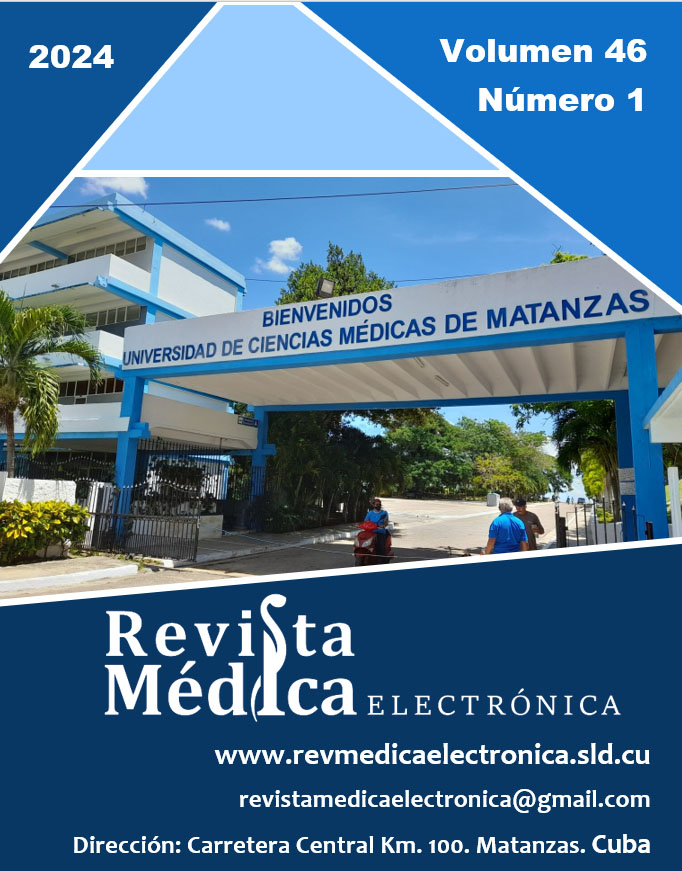Effect of COVID-19 on the oral cavity
Keywords:
coronavirus, pandemic, COVID-19, oral cavityAbstract
Introduction: At the end of 2019, in Wuhan, People’s Republic of China, cases of a new coronavirus were notified which, as a result of its capacity for respiratory transmission, overcrowding of local population, and international trafficking of people and goods managed to reach the category of global pandemic. It is an infection that causes severe acute respiratory syndrome. In the literature consulted studies were found about the oral cavity as the main route of infection by SARS-CoV-2, and the impact of the high risk of contagion on dental practice. This work aims to determinate the implications in the oral cavity of patients that are convalescent from COVID-19.
Methods: A descriptive, cross-sectional and observational study was carry out in the convalescent COVID-19 population of the municipality of Cárdenas, between December 2020 and March 2021.
Results: Female sex predominated in the selected sample; the age group that prevailed was the one between 35 to 59 years old, and high blood pressure prevailed as a chronic non-communicable disease. Patients were described with the so called “COVID tongue” and gum bleeding who at the same time presented xerostomia, all after receiving the first dose of IFN-alfa or HeberFERON.
Conclusions: Ageusia and anosmia were the predominant oral manifestations in COVID-19 convalescent individuals in the territory.
Downloads
References
2. Li Q, Guan X, Wu P, et al. Early transmission dynamics in Wuhan, China, of novel coronavirus-infected pneumonia. N Engl JMed [Internet]. 2020 [citado 14/01/2021];382(13):1199-207. Disponible en: https://www.nejm.org/doi/full/10.1056/NEJMOa2001316
3. Bermúdez-Jiménez C, Gaitán-Fonseca C, Aguilera-Galaviz L. Patient management in dental care and staff biosecurity during the SARS-CoV-2 coronavirus outbreak (COVID-19). Rev ADM [Internet]. 2020 [citado 14/01/2021];77(2):88-95. Disponible en: https://www.medigraphic.com/pdfs/adm/od-2020/od202f.pdf
4. Ramírez Velásquez M, Medina Sotomayor P, Morocho Macas AA. Enfermedad por Coronavirus 2019 (COVID-19) y su repercusión en la consulta odontología: una revisión. Odont SM [Internet]. 2020 [citado 14/01/2021];23(2):139-46. Disponible en: https://revistasinvestigacion.unmsm.edu.pe/index.php/odont/article/view/17758
5. Melián Rivas A, Calcumil Herrera P, Boin Bakit C, et al. Detección de COVID-19 (SARS-CoV-2) mediante la saliva: una alternativa diagnóstica poco invasiva. Int J Odontostomat [Internet]. 2020 [citado 14/01/2021];14(3):316-20. Disponible en: https://www.scielo.cl/scielo.php?script=sci_arttext&pid=S0718-381X2020000300316
6. Da Silva Pedrosa M, Sipert CR, Neves Nogueira F. Salivary glands, saliva and oral findings in COVID-19 infection. Pesqui Bras Odontopediatria Clin Integr [Internet]. 2020 [citado 14/01/2021];20(Suppl 1):e0104. Disponible en: https://www.scielo.br/j/pboci/a/g7yjgvnJTSTYjB4mPQKWLkJ/?lang=en
7. Baghizadeh Fini M. Oral saliva and COVID-19. Oral Oncol [Internet]. 2020 [citado 14/01/2021];108:104821. Disponible en: https://www.ncbi.nlm.nih.gov/pmc/articles/PMC7250788/
8. Garrod M. Disgeusia, hipogeusia o agusia, podría ser uno de los cientos de miles de seres humanos en el mundo que sufren este tipo de trastornos [Internet]. Ciudad de México: CódigoF; 2019 [citado 14/01/2021]. Disponible en: https://codigof.mx/disgeusia-hipogeusia-o-agusia-podria-ser-uno-de-los-cientos-de-miles-de-seres-humanos-en-el-mundo-que-sufren-este-tipo-de-trastornos/
9. Abedul Farma. Anosmia e hiposmia, ¿sabes identificar los principales trastornos del olfato? [Internet]. Navarra: Abedul Farma; 2021 [citado 21/06/2021]. Disponible en: https://www.abedulfarma.com/anosmia/anosmia-e-hiposmia-sabes-identificar-los-principales-trastornos-del-olfato/
10. Cruz Tapia RO, Peraza Labrador AJ, Guimaraes DM, et al. Oral mucosal lesions in patients with SARS‐CoV‐2 infection. Report of four cases. Are they a true sign of COVID‐19 disease? Spec Care Dentist [Internet]. 2020 [citado 14/01/2021];40(6):555-60. Disponible en: https://onlinelibrary.wiley.com/doi/10.1111/scd.12520
11. Iranmanesh B, Khalili M, Amiri R, et al. Oral manifestations of COVID-19 disease: A review article. Dermatol Ther [Internet]. 2020 [citado 14/01/2021];34(1):e14578. Disponible en: https://onlinelibrary.wiley.com/doi/10.1111/dth.14578
12. Halboub E, Al-Maweri SA, Alanazi RH, et al. Orofacial manifestations of COVID-19: a brief review of the published literature. Braz Oral Res [Internet]. 2020 [citado14/01/2021];34:e124. Disponible en: https://www.scielo.br/j/bor/a/DRqH7Qp4RPm6XbCT7Y4mfZN/
13. Bermúdez Bermúdez M, Cuadro Montero KM, Parra Sanabria EA. Manifestaciones en la cavidad bucal y en la cara asociadas a la COVID-19. Univ Med [Internet]. 2021 [citado 23/09/2021];62(3). Disponible en: https://revistas.javeriana.edu.co/index.php/vnimedica/article/view/33206
14. Vivas MA. ¿Por qué el covid-19 afecta más a los hombres que a las mujeres? [Internet]. Bogotá: Consultorsalud; 2021 [citado 23/09/2021]. Disponible en: https://consultorsalud.com/por-que-el-covid-19-afecta-mas-a-hombres/
15. Ríos González CM, Ríos González DN. Percepción del riesgo de la enfermedad COVID-19 y sus factores relacionados en Paraguay. Rev Nac (Itauguá) [Internet]. 2020 [citado 14/01/2021];12(2):4-15. Disponible en: http://scielo.iics.una.py/scielo.php?script=sci_arttext&pid=S2072-81742020000200004
16. Santos Velázquez T, Aciet Cruz L. Manifestaciones bucales en pacientes con COVID-19 atendidos en un centro de aislamiento en Las Tunas. Rev electrón Dr Zoilo E Marinello Vidaurreta [Internet]. 2021 [citado 23/09/2021];46(3):2808. Disponible en: http://revzoilomarinello.sld.cu/index.php/zmv/article/view/2808/pdf_796
17. Vaira LA, Salzano G, Deiana G, et al. Anosmia and ageusia: common findings in COVID-19 patients. Laryngoscope [Internet]. 2020 [citado 23/09/2021];130(7):1787. Disponible en: https://www.ncbi.nlm.nih.gov/pmc/articles/PMC7228304/
18. Martínez Pizarro S. Impacto de la COVID-19 en otorrinolaringología. Rev Cubana Otorrin Laringol Cabeza y Cuello [Internet]. 2020 [citado 23/09/2021];4(3). Disponible en: http://www.revotorrino.sld.cu/index.php/otl/article/view/149
19. León-Castellón R, Bender-del-Busto JE, Velázquez-Pérez L. Disfunción olfatoria y COVID-19. Anales de la Academia de Ciencias de Cuba [Internet]. 2020 [citado 23/09/2021];10(2). Disponible en: http://www.revistaccuba.cu/index.php/revacc/article/view/817/836
20. Sepúlveda CV, Waissbluth AS, González GC. Anosmia y enfermedad por Coronavirus 2019 (COVID-19): ¿Qué debemos saber? Rev Cubana Otorrin Laringol Cabeza y Cuello [Internet]. 2020 [citado 23/09/2021];80(2):247-58. Disponible en: https://www.scielo.cl/scielo.php?script=sci_arttext&pid=S0718-48162020000200247
21. Hopkins C, Kumar N. Loss of sense of smell as marker of COVID-19 infection [Internet]. London: ENT UK; 2020 [citado 23/09/2021]. Disponible en: https://www.entuk.org/_userfiles/pages/files/loss_of_sense_of_smell_as_marker_of_covid.pdf
Downloads
Published
How to Cite
Issue
Section
License
All content published in this journal is Open Access, distributed under the terms of the CC BY-NC 4.0 License.
It allows:
- Copy and redistribute published material in any medium or format.
- Adapt the content.
This will be done under the following terms:
- Attribute the authors' credits and indicate whether changes were made, in which case it must be in a reasonable way.
- Non-commercial use.
- Recognize the journal where it is published.
The copyrights of each article are maintained, without restrictions.






